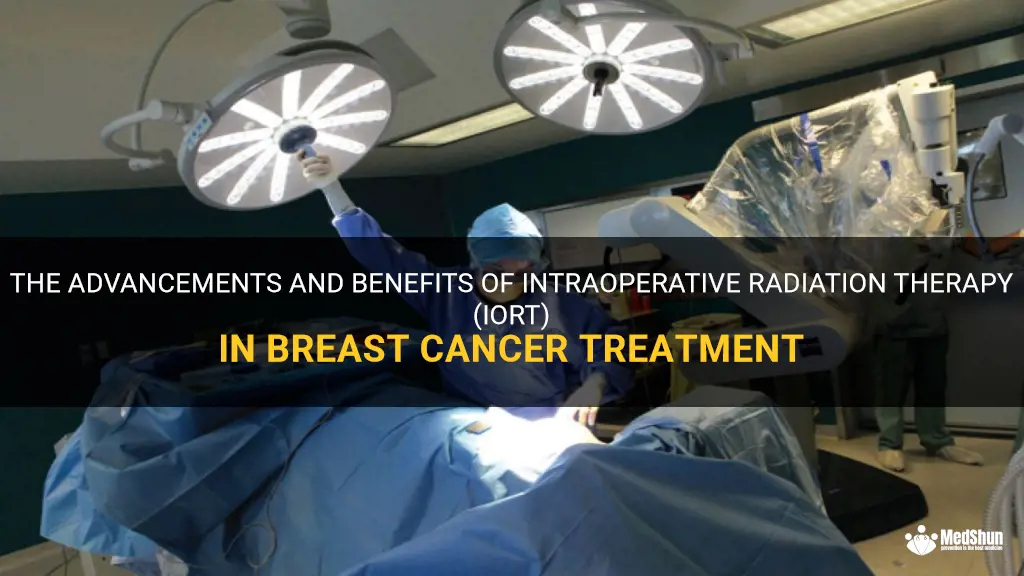
Breast cancer is the most common cancer among women worldwide, with millions of new cases being diagnosed each year. While there are different treatment options available, one treatment method that has gained attention in recent years is intraoperative radiation therapy (IORT). This innovative approach delivers targeted radiation directly to the tumor site during surgery, reducing the need for additional radiation treatments after surgery. In this article, we will explore the benefits and potential drawbacks of IORT, and how it is revolutionizing breast cancer treatment.
| Characteristics | Values |
|---|---|
| Treatment | IORT |
| Type | Localized radiation therapy |
| Delivery | Directly to tumor bed during surgery |
| Benefits | Reduced treatment time, fewer side effects |
| Side effects | Skin irritation, fatigue, temporary hair loss |
| Success rate | Varies depending on stage and other factors |
| Cost | Varies depending on location and insurance coverage |
| Availability | Limited to certain hospitals and clinics |
| Overall safety | Generally safe with proper techniques |
| Recovery time | Faster compared to traditional radiation therapy |
What You'll Learn
- What is IORT and how does it fit into breast cancer treatment?
- What are the advantages and disadvantages of using IORT compared to traditional radiation therapy for breast cancer?
- How is the decision made to use IORT as part of a patient's breast cancer treatment plan?
- Are there any specific types or stages of breast cancer that are better suited for IORT treatment?
- What is the long-term efficacy and success rate of IORT in breast cancer patients compared to other treatment options?

What is IORT and how does it fit into breast cancer treatment?
Breast cancer is one of the most common cancers affecting women worldwide. In recent years, there have been major advancements in the treatment of breast cancer, including the use of intraoperative radiation therapy (IORT).
IORT is a technique in which a high dose of radiation is delivered to the tumor bed during surgery. Traditionally, patients with breast cancer would receive external beam radiation therapy (EBRT) after surgery. However, with IORT, the radiation is given at the same time as the surgery, eliminating the need for additional radiation treatments.
The main advantage of IORT is that it enables the delivery of a highly focused dose of radiation directly to the tumor bed, while minimizing the exposure of healthy surrounding tissue. This targeted approach helps to lower the risk of radiation-related side effects and allows for better cosmetic outcomes.
The procedure for IORT involves several steps. First, the patient undergoes surgery to remove the tumor, which typically involves a lumpectomy or mastectomy. Then, the radiation oncologist uses a specialized device to deliver a single, high-dose radiation treatment directly to the area where the tumor was removed. This can be achieved using different techniques, such as using a mobile electron linear accelerator or inserting a balloon catheter into the tumor bed and delivering the radiation from within.
IORT is usually offered to patients with early-stage breast cancer who meet certain criteria. These criteria include having a single tumor that is less than a certain size, no involvement of the lymph nodes, and no evidence of cancer spread to other parts of the body. It is not appropriate for all breast cancer patients, and the decision to offer IORT is made on a case-by-case basis.
The use of IORT as part of breast cancer treatment has been shown to be safe and effective. Multiple studies have demonstrated that it is as effective as traditional EBRT in terms of local tumor control and survival rates. In addition, IORT has been associated with a lower incidence of complications, such as skin toxicity and fibrosis.
Furthermore, IORT offers several advantages in terms of patient convenience and quality of life. Since the radiation is delivered during surgery, it eliminates the need for prolonged radiation treatments, which can be time-consuming and disruptive to daily life. In addition, the focused delivery of radiation reduces the risk of damage to surrounding organs and tissues, minimizing the potential for long-term side effects.
However, it is important to note that IORT is still a relatively new technique, and more research is needed to further establish its long-term outcomes and benefits. Additionally, not all medical centers have the necessary equipment and expertise to offer IORT, so it may not be available to all patients.
In conclusion, IORT is an innovative approach to breast cancer treatment that offers many advantages over traditional radiation therapy. It allows for the delivery of a highly focused dose of radiation during surgery, minimizing the need for additional treatments and reducing the risk of side effects. While it may not be suitable for all patients, it has shown promising results in terms of efficacy and quality of life for those who are eligible. As research in this field continues to evolve, it is likely that IORT will play an increasingly important role in the management of breast cancer.
The Latest Advances in AAFP Breast Cancer Treatment: What You Need to Know
You may want to see also

What are the advantages and disadvantages of using IORT compared to traditional radiation therapy for breast cancer?
Advantages and Disadvantages of Using Intraoperative Radiation Therapy (IORT) Compared to Traditional Radiation Therapy for Breast Cancer
Breast cancer is one of the most prevalent forms of cancer among women, and radiation therapy has long been an important treatment modality for this disease. Traditionally, external beam radiation therapy (EBRT) has been used to target cancer cells after surgery, but in recent years, a technique known as intraoperative radiation therapy (IORT) has gained popularity. IORT involves delivering a single dose of radiation directly to the surgical site during the operation. While IORT offers certain advantages over traditional radiation therapy, there are also disadvantages that must be considered. In this article, we will explore the advantages and disadvantages of using IORT compared to traditional radiation therapy for breast cancer.
Advantages of IORT:
- Reduced treatment time: One of the significant advantages of IORT is that it allows for a significantly reduced treatment time. Whereas traditional radiation therapy can span over several weeks, IORT can be completed in a single session lasting about 30 minutes. This reduces the burden on patients, as they do not have to visit the hospital for daily treatments for an extended period.
- Precise targeting of radiation: In IORT, radiation is delivered directly to the surgical site, allowing for precise targeting of the cancer cells and minimizing damage to healthy tissues surrounding the tumor. This targeted approach can lead to better outcomes and decreased side effects associated with radiation therapy.
- Higher radiation dose: Due to the localized nature of IORT, higher radiation doses can be delivered to the tumor bed without significantly increasing the risk of toxicity to healthy tissues. This increased radiation dose may improve tumor control rates and reduce the chances of recurrence.
- Fewer side effects: Traditional radiation therapy can cause side effects such as skin irritation, fatigue, and long-term complications like cardiac toxicity and second cancers. IORT, on the other hand, has been shown to have fewer side effects and may improve patients' quality of life during and after treatment.
Disadvantages of IORT:
- Limited applicability: IORT is not suitable for all breast cancer patients. It is primarily recommended for patients with early-stage breast cancer who meet specific criteria, such as smaller tumor size and absence of lymph node involvement. Patients with larger tumors or lymph node involvement may require additional EBRT after surgery.
- Lack of long-term data: While IORT has shown promise in terms of its immediate benefits, there is a lack of long-term data on its efficacy and potential late effects. Long-term studies are needed to assess the durability of tumor control and the risk of late side effects such as fibrosis or recurrence.
- Cost and availability: IORT requires specialized equipment and trained personnel, which may limit its availability in certain healthcare facilities. Additionally, the initial cost of acquiring the equipment and establishing an IORT program can be high, potentially making it less accessible for some patients.
- Learning curve: Performing IORT requires surgical skill and coordination with radiation oncologists. Surgeons and radiation oncologists need to work closely together to ensure the accurate delivery of radiation during surgery. The learning curve associated with adopting IORT may pose challenges at the beginning.
In conclusion, IORT offers several advantages over traditional radiation therapy for breast cancer, including reduced treatment time, precise targeting of radiation, higher radiation doses, and fewer side effects. However, it also has certain limitations, such as limited applicability, a lack of long-term data, cost, and the learning curve associated with its implementation. It is essential for healthcare professionals to carefully evaluate the suitability of IORT for individual patients and consider the available resources and expertise before adopting this technique. Further research and long-term studies are necessary to establish the effectiveness and safety of IORT in the management of breast cancer.
The Ultimate Breast Cancer Treatment Checklist: Ensuring Comprehensive Care and Treatment Options
You may want to see also

How is the decision made to use IORT as part of a patient's breast cancer treatment plan?
Intraoperative radiation therapy (IORT) is an innovative approach to treating breast cancer. It involves delivering a targeted dose of radiation directly to the tumor bed during surgery, eliminating the need for further radiation treatments after surgery. The decision to use IORT as part of a patient's breast cancer treatment plan is typically made based on a variety of factors, including tumor characteristics, patient preferences, and clinical guidelines.
To determine whether a patient is a suitable candidate for IORT, several key factors are taken into consideration. Firstly, the size of the tumor is an important factor. IORT is most commonly indicated for small tumors, typically less than 3 cm in size. This is because the radiation dose delivered during IORT is limited by the proximity to critical structures such as the heart and lungs. For larger tumors, alternative treatment options may be more appropriate.
In addition to tumor size, the type of breast cancer also plays a role in the decision-making process. IORT is best suited for early-stage breast cancers, such as ductal carcinoma in situ (DCIS) or early invasive breast cancers. These types of breast cancers are typically localized to the breast and have a low risk of spreading to other parts of the body. Patients with more advanced or aggressive breast cancers may require additional treatment modalities, such as chemotherapy or whole breast radiation therapy.
Patient factors, such as age and overall health, also influence the decision to use IORT. Older patients or those with multiple comorbidities may have a higher risk of complications from surgery or radiation therapy. In these cases, IORT may be a suitable alternative to traditional whole breast radiation therapy, which typically involves daily treatments over several weeks. IORT can be completed in a single session during surgery, minimizing the overall treatment time and reducing the burden on the patient.
Another important consideration is the patient's preferences and values. Some patients may have strong preferences for a particular treatment approach, and their input should be taken into account when making decisions about their care. It is essential for healthcare providers to have open and honest discussions with patients about the potential benefits and risks of IORT, as well as alternative treatment options. This shared decision-making approach allows patients to make informed choices that align with their individual values and goals.
Clinical guidelines and evidence-based medicine also play a significant role in the decision-making process. Several professional organizations, such as the American Society of Breast Surgeons and the European Society of Breast Cancer Specialists, have developed guidelines for the use of IORT in breast cancer treatment. These guidelines provide recommendations based on the available scientific evidence and help healthcare providers identify which patients are most likely to benefit from IORT.
In summary, the decision to use IORT as part of a patient's breast cancer treatment plan is made based on a comprehensive assessment of tumor characteristics, patient preferences, and clinical guidelines. Tumor size, type of breast cancer, patient factors, and individual values all play a role in determining the appropriateness of IORT. By considering these factors holistically and involving the patient in the decision-making process, healthcare providers can develop a personalized treatment plan that maximizes both the potential benefits and the patient's quality of life.

Are there any specific types or stages of breast cancer that are better suited for IORT treatment?
Intraoperative radiation therapy (IORT) is a treatment option for certain types and stages of breast cancer. It involves delivering a concentrated dose of radiation directly to the tumor bed during surgery, immediately after the tumor has been removed.
While IORT can be used in various situations, there are specific types and stages of breast cancer that are better suited for this treatment modality. These include:
- Early-stage breast cancer: IORT is most commonly used in patients with early-stage breast cancer. It can be an alternative to external beam radiation therapy (EBRT) in selected cases. Early-stage breast cancer refers to tumors that are small and confined to the breast and nearby lymph nodes.
- Low-risk, favorable pathology: IORT is generally recommended for patients with low-risk, favorable pathology. This means that the tumor has characteristics indicating a lower risk of recurrence, such as smaller size, clear margins, and absence of lymph node involvement. In such cases, IORT can provide effective local control with a single radiation dose.
- Older patients: IORT may be particularly suitable for older patients who may have comorbidities or are unable to tolerate a longer course of conventional radiation therapy. The shorter treatment time offered by IORT can be beneficial in reducing the overall treatment burden for these individuals.
- Tumors with favorable histology: Certain histological subtypes of breast cancer, such as ductal carcinoma in situ (DCIS) and lobular carcinoma in situ (LCIS), may be more amenable to IORT. These subtypes tend to have a lower risk of recurrence and can be effectively treated with IORT.
It is important to note that not all patients with breast cancer will be eligible for IORT. Each case needs to be evaluated individually, taking into consideration various factors such as tumor size, lymph node involvement, tumor grade, and overall health status of the patient.
IORT is typically performed using specialized techniques, such as the Intrabeam™ system, which delivers radiation directly to the tumor bed using a miniaturized X-ray source. The procedure is carried out in the operating room immediately after the tumor has been removed. The radiation is targeted specifically to the area at highest risk of recurrence, sparing surrounding healthy tissues.
Numerous studies have demonstrated the effectiveness and safety of IORT in appropriately selected patients. One study published in the Lancet Oncology journal reported that IORT was non-inferior to EBRT in terms of local recurrence rates after five years of follow-up.
In conclusion, there are specific types and stages of breast cancer that are better suited for IORT treatment. This includes early-stage breast cancer, low-risk favorable pathology, older patients, and tumors with favorable histology. IORT offers an alternative option to conventional external beam radiation therapy for eligible patients, providing effective local control with a shorter treatment time. It is important for patients to have a thorough evaluation by a multidisciplinary team to determine the best treatment approach for their specific case.
The Latest Advancements in Treating Stage 3 Breast Cancer: Which Treatment Is Considered the Best?
You may want to see also

What is the long-term efficacy and success rate of IORT in breast cancer patients compared to other treatment options?
In recent years, there has been a growing interest in the use of intraoperative radiation therapy (IORT) in the treatment of breast cancer. IORT involves delivering a single, high dose of radiation directly to the tumor bed during surgery, immediately following the removal of the tumor. This approach is seen as a more targeted and efficient way to deliver radiation therapy, compared to the traditional external beam radiation therapy which requires multiple sessions over several weeks.
One of the key benefits of IORT is its potential to minimize the risk of a recurrence of breast cancer. By delivering radiation directly to the tumor bed, IORT can effectively sterilize any remaining cancer cells that may be present after surgery. This greatly reduces the chances of the cancer coming back and improves the long-term success rate of the treatment.
Several studies have been conducted to evaluate the long-term efficacy and success rate of IORT in breast cancer patients compared to other treatment options. One such study published in the Journal of Clinical Oncology in 2014 followed a group of 1,400 breast cancer patients who underwent IORT as part of their treatment. The study found that the 5-year local recurrence rate was significantly lower in the IORT group compared to the external beam radiation therapy group (2.1% vs 5.2%). This indicates that IORT is indeed effective in reducing the risk of local recurrence.
Another study published in the Annals of Surgical Oncology in 2018 examined the long-term outcomes of 1,200 breast cancer patients who received IORT as their primary radiation therapy. The study found that the 10-year overall survival rate was comparable to that of patients who received traditional external beam radiation therapy. This suggests that IORT is not only effective in preventing local recurrence but also does not compromise overall survival.
While these studies provide encouraging results, it is important to note that IORT may not be suitable for all breast cancer patients. The decision to undergo IORT should be made based on careful consideration of various factors such as tumor size, lymph node involvement, and patient preferences. Additionally, long-term follow-up is needed to further assess the efficacy and success rate of IORT in breast cancer patients.
In conclusion, IORT is emerging as an effective treatment option for breast cancer patients. It offers the potential for reduced local recurrence rates and comparable overall survival rates compared to traditional external beam radiation therapy. However, further research and long-term follow-up are needed to fully understand the long-term efficacy and success rate of IORT in breast cancer patients. Patients should work closely with their healthcare providers to determine if IORT is the right treatment option for them.
Understanding the Stage 3 Breast Cancer Treatment Timeline: A Comprehensive Guide
You may want to see also
Frequently asked questions
IORT is a specialized form of radiation therapy that delivers a high dose of radiation directly to the tumor site during surgery. It is used as a boost treatment to kill any remaining cancer cells after the tumor has been removed.
During surgery, a small device called an applicator is placed directly into the tumor bed. This applicator delivers a concentrated dose of radiation to the surrounding tissue. The radiation kills any remaining cancer cells and reduces the risk of recurrence.
One of the main benefits of IORT is that it reduces the overall treatment time for breast cancer patients. Instead of receiving weeks of postoperative radiation therapy, the patient can receive a high dose of radiation in a single session. This saves time and reduces the overall side effects associated with radiation treatment.
IORT is generally well-tolerated by patients, but there are some potential risks and side effects. These can include skin discoloration, swelling, or tenderness in the breast, and a small risk of damage to nearby organs. However, overall, the side effects of IORT are typically less severe compared to traditional radiation therapy.
IORT is typically used for early-stage breast cancer patients who have had a lumpectomy. It may be recommended for patients with small tumors, clear margins, and no lymph node involvement. However, each patient's case is unique, and the decision to undergo IORT should be made in consultation with a healthcare professional.







